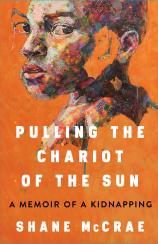Reading Group Guide
Discussion Questions
Pulling the Chariot of the Sun: A Memoir of a Kidnapping

1. Shane is a poet, and this background is reflected throughout this lyrical memoir. Discuss some of the most poetic passages of the book. How do poetics or lyrical prose help craft the story Shane wants to convey?
2. The act of naming --- and the lack of it --- takes on an important role in forming Shane’s conception of self, as well as his conception of those around him. For example, the central adult figure throughout the book takes on many names: grandmother, “Mom,” kidnapper. Discuss other examples of how naming functions throughout this memoir.
3. Even though Shane is candid about not remembering much of his childhood, in-depth details abound as he pieces together a mosaic of his life, whether it’s the dining room table on page 7 or the kind of gum his grandmother chewed on page 42. What significance does detail play in Shane’s memories and in memory in general?
4. Towards the beginning of the book, the titular metaphor of the “chariot of the sun” is introduced, which the narrator pulls through “clouds so thick and dark he can’t see the chariot behind him, though its heat reaches through the clouds and scorches his back, though he thinks he is running from the thing he is pulling” (page 21). How does this metaphor function throughout the rest of the book?
5. Vehicles can be found in many parts of the story, whether they’re chariots for pulling, cars for warming, or bikes for riding wheelies down the street. What do you make of this motif? Do you think each kind of vehicle signifies something different from the others?
6. This is a memoir comprised of vignettes, and the structure of the text is fragmented. How does the fragmented nature of the text further illustrate Shane’s story?
7. The color white appears in various motifs throughout the book, most often in relation to race but also to describe the quartz by the riverbank and the material of a headstone. Why do you think this reappears? Can you think of more occurrences of white objects or references throughout the book?
8. Shane refers to having memory holes and “blocked memories,” often candidly telling us he doesn’t know if he’s directly recalling a memory. How do these memory holes relate to the structure of the book? Does the fragmented structure leave anything unsaid? If so, what? Does the structure of the text create a kind of redemption for Shane’s lapses in memory?
9. How did each of Shane’s hometowns differ from one another? How did his inner world change as his physical world did?
10. “Eventually you have to start hiding to stay lost,” writes Shane. Feeling (and being!) lost is a huge theme in the book. What kind of relationship does the author have with lostness? How and when has that relationship fluctuated?
11. Shane asks if it’s “possible to disown up” (page 15). Do you think it is?
12. The search for identity is one of the central themes of the book. When was a time in your life when you were searching for identity? What people, places and details did you cling to, and why?
Pulling the Chariot of the Sun: A Memoir of a Kidnapping
- Publication Date: August 1, 2023
- Genres: Memoir, Nonfiction
- Hardcover: 272 pages
- Publisher: Scribner
- ISBN-10: 1668021749
- ISBN-13: 9781668021743







